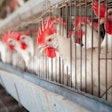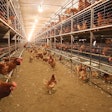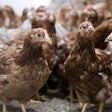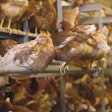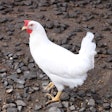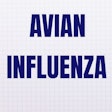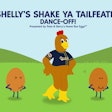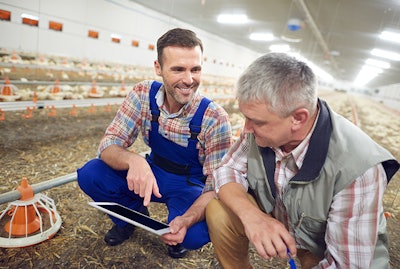
An effective vaccination strategy is important to every broiler management program. Vaccines trigger the immune system to prepare for disease onset by introducing a less virulent organism or portion of an organism to a bird, pre-exposing it to disease threat. The bird produces antibodies and other immunological factors to combat the disease. Should the bird later be exposed to a virulent organism, its body is prepared to fight the disease.
Deciding which vaccines to use on broilers is not always straightforward. It can be frustrating and economically costly when vaccines are ineffective or less effective. Consider the following principles when deciding what vaccines to use in a broiler program:
1. Follow good management practices
Any vaccination program starts with good flock management. When birds are stressed they are less able to fight infections with or without vaccines. Ensure proper ventilation, spacing, and feed requirements. In addition, remain aware of the vaccines commercially available in your area and, as warranted, adjust vaccine use.
2. Handle vaccines properly
Improper vaccine handling may reduce or destroy the ability of a vaccine to provide protection. Ensure vaccines are stored properly and protected from heat and direct sunlight. Do not use expired vaccines and rotate vaccine stock to avoid having to throw away expired product. Follow label instructions and avoid contamination during mixing and administering. Use a vaccine within the timeframe recommended by the manufacturer and dispose of opened containers and remaining product properly.
3. Evaluate organisms infecting your area
Since vaccines must trigger an immune response to provide protection, they will cause some stress to the bird which could impact growth. Especially with the short growing time of broilers, it is important to monitor the diseases in your operation and nearby operations. Unless required by national authorities, only vaccinate for the diseases impacting your region.
4. Consider local organism characteristics, strains/variants
Some diseases are caused by multiple organisms or organisms with divergent, genetically dissimilar serotypes. Depending on the organism infecting your region, different vaccines may be required.
In addition, some organisms mutate faster than others. When a mutated organism becomes less genetically similar to the original organism used in vaccine production, the vaccine may become less effective or ineffective over time. Avian influenza and infectious bronchitis are examples of disease with higher mutation frequencies.
Use polymerase chain reaction testing or other serotype methods to determine the organisms causing disease in your region and adjust vaccines accordingly.

In any vaccine plan, start with the basics, then modify to address local conditions and diseases. (Mary Jo Davis)
5. Understand vaccine characteristics
The two types of vaccines traditionally used in broilers are live and killed vaccines.
- Live vaccines (including live attenuated and modified live vaccines) contain live organisms that are naturally less virulent or have been modified and weakened during manufacturing to be less virulent. Although live vaccines provide a strong, quick immune response, they can cause some disease symptoms, including growth suppression. Live vaccines are suitable for group application.
- Killed or inactivated vaccines contain dead organisms. While killed vaccines do not cause disease, they provide a weaker, slower immune response, must be injected into each bird, and cost more to produce.
Depending on the disease, one or both types of vaccines may be available or should be used. Consider the strength and weaknesses of each type to make better decisions regarding broiler flock inoculation.
Additional vaccine types include subunit, toxoid, and recombinant vaccines. As with live and killed vaccines, these types have strengths and weaknesses. Research each vaccine type prior to adding it to a vaccine program.
6. Inoculate birds at the appropriate time
Vaccines work best when administered in advance of the disease state, allowing the bird to prepare for the infection. Once birds catch a disease, vaccine administration may actually be detrimental, causing additional stress to the bird and inhibiting growth. For diseases known to infect birds early, consider using egg or hatchery vaccination. For vaccines impacted by maternal antibodies, wait until birds are around 10-18 days old, depending on the disease you are vaccinating against. Do not vaccinate birds already manifesting disease symptoms.
7. Optimize delivery methods
For vaccines requiring injection, use in-ovo or hatchery injection.
- In-ovo injection: vaccines are injected into the embryo or amniotic fluid around 18-19 days of incubation, when eggs are being transferred from the incubator to the hatcher. Control the risk of embryo contamination by using a two-needle injection system or a proper needle disinfection system, properly training personnel, maintaining a sterile environment in the injection area and automating the process when possible. Advantages of in-ovo injection include less handling of birds, protecting birds from early infections, and uniform administration of the vaccine. Marek’s disease, Newcastle disease, and infectious bursal disease vaccines are some of the vaccines administered via in-ovo injection.
- Day-old chick injection: One day of age is the most practical time to inject broilers with vaccines because inoculation occurs as the birds are being transferred from the hatchery to crates for shipment to broiler houses. Birds are injected subcutaneously, usually at the back of the neck. Train personnel to inject the bird under the skin, not into the feathers.
Use the following for group application of vaccines:
- Spray application at the hatchery: chicks are sprayed with vaccines in crates for shipment. Use this method with vaccines suitable for group treatment and requiring early application
- Spray application in the broiler house: For application to older birds, the vaccine is sprayed onto birds or into the air above the birds. The bird inhales or ingests the vaccine. To avoid stressing birds during spray application, workers or vehicles used for spraying should routinely travel through the house to acclimatize the birds to their presence. Ensure uniform inoculation by spraying the entire house in an overlapping pattern.
- Drinking water administration: While this method is the least stressful to the birds, uniform inoculation only occurs if all birds drink water during the administration period. Sanitizers and chemicals such as chlorine will destroy live vaccines and must be eliminated from the water supply prior to and during vaccine administration.
Although no vaccine strategy is fool proof, consider these principles to improve vaccine strategy decisions.

Examples of vaccine delivery equipment to: inject eggs, inject day old chicks, spray day old chicks and spray broiler houses. (Courtesy of Ceva Animal Health)
10 tips for cleaning, disinfecting broiler houses
www.WATTAgNet.com/articles/26539




